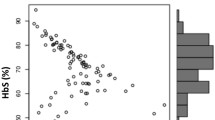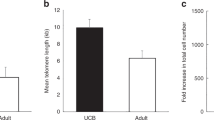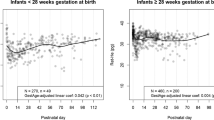Abstract
The possibility of using umbilical cord blood for transplantation in several enzyme deficiencies has received increasing attention because of the availability of cord blood, the reduced incidence of post-transplantation complications, such as graft-versus-host disease and the possible accomplishment of good corrective results following transplantation, even in cases of greater HLA disparity. The use of hematopoietic stem cells from unrelated donors is even more highly recommended for the treatment of inherited enzyme deficiencies, because it might reduce the risk of the transplanted cells originating from a carrier of the defect, which might have an inadequate corrective ability. Our study was designed to elucidate whether the gestational age and mode of delivery influences the arylsulfatase-A activity in the umbilical cord blood. Enzyme activities proved to be similar in the four populations studied (full-term normal spontaneous vaginal delivery, full-term caesarean section, preterm normal spontaneous vaginal delivery and preterm caesarean section). Therefore, umbilical cord blood samples seem to be suitable for transplantation in metachromatic leukodystrophy, regardless of gestational age and mode of delivery. Moreover, our results are the first published data on normal values for arylsulfatase-A activity in human umbilical cord blood.
Bone Marrow Transplantation (2002) 29, 487–490. doi:10.1038/sj.bmt.1703405
This is a preview of subscription content, access via your institution
Access options
Subscribe to this journal
Receive 12 print issues and online access
$259.00 per year
only $21.58 per issue
Buy this article
- Purchase on Springer Link
- Instant access to full article PDF
Prices may be subject to local taxes which are calculated during checkout

Similar content being viewed by others
References
Von Figura K, Schmidt B, Selmer T, Dierks T . A novel protein modification generating an aldehyde group in sulfatases: its role in catalysis and disease BioEssays 1998 20: 505 510
Parenti G, Meroni G, Ballabio A . The sulfatase gene family Curr Opin Genet Dev 1997 7: 386 391
Krivit W, Peters C, Shapiro EG . Bone-marrow transplantation as effective treatment of central nervous system disease in globoid cell leukodystrophy, metachromatic leukodystrophy, adrenoleukodystrophy, mannosidosis, fucosidosis, aspartylglucosaminuria, Hurler, Maroteaux-Lamy, Sly syndromes and Gaucher disease Type III Curr Opin Neurol 1999 12: 167 176
Kurtzberg J, Laughlin M, Graham ML et al. Placental blood as a source of hematopoietic stem cells for transplantation into unrelated patients New Engl J Med 1996 335: 157 166
Wagner JE, Rosenthal J, Sweetman R et al. Successful transplantation of HLA-matched and HLA mismatched umbilical cord blood from unrelated donors: analysis of engraftment and acute graft-versus-host disease Blood 1996 88: 795 802
Wagner JE, Kurtzberg J . Cord blood stem cells Curr Opin Hematol 1997 4: 413 418
Pulkkinen M . Arylsulfatase and the hydrolysis of some steroid sulphatases in developing organism and placenta Acta Physiol Scand 1961; 32 1961 (Suppl. 180)
Németh M, László A, Kovács A, Falkay G . Lysosomal enzyme activities in frozen, non-cultured chorionic villi for prenatal diagnosis of enzymopathies Acta Med Hung 1992–93 49: 143 148
Peters C, Shapiro EG, Anderson J et al. Hurler syndrome: Outcome of HLA-genotypically identical sibling and HLA haploidentical related donor bone marrow transplantation in fifty-four children Blood 1998 91: 2601 2608
de Gasperi R, Raghavan SS, Gama Sosa MA et al. Measurement from umbilical cord blood of four lysosomal enzymatic activities: α-L-iduronidase (Hurler), galactocerebrosidase (globoid cell leukodystrophy, arylsulfatase A (metachromatic leukodystrophy), arylsulfatase B (Maroteaux-Lamy) Bone Marrow Transplant 2000 25: 541 544
Lowry OH, Rosebrough NJ, Farr AL et al. Protein measurement with the Folin reagent J Biol Chem 1951 193: 265 275
Singh J, Tavella S, Di Ferrante N . Measurements of arylsulfatases A and B in human serum J Pediatr 1975 86: 574 576
Baldinger S, Pierpont ME, Wenger DA . Pseudodeficiency of arylsulfatase A: a counseling dilemma Clin Genet 1987 31: 70 76
Author information
Authors and Affiliations
Rights and permissions
About this article
Cite this article
Georgeson, G., Szöny, B., Streitman, K. et al. Arylsulfatase-A in umbilical cord blood: gestational age and mode of delivery do not influence enzyme activity. Bone Marrow Transplant 29, 487–490 (2002). https://doi.org/10.1038/sj.bmt.1703405
Received:
Accepted:
Published:
Issue Date:
DOI: https://doi.org/10.1038/sj.bmt.1703405



